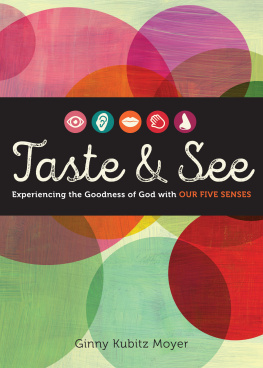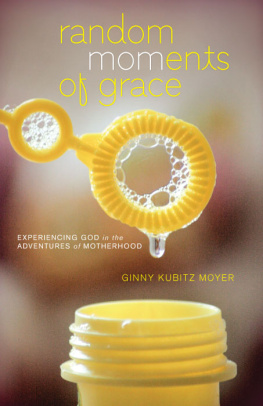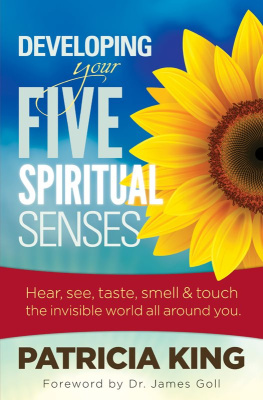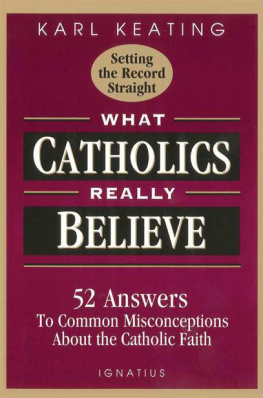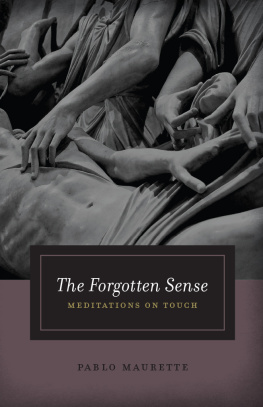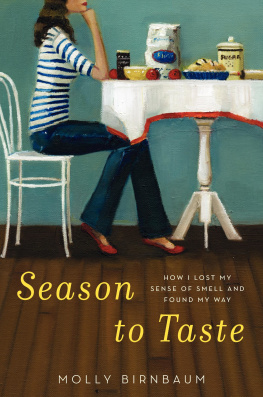And God saw that it was good.

3441 N. Ashland Avenue
Chicago, Illinois 60657
(800) 621-1008
www.loyolapress.com
2016 Ginny Kubitz Moyer
All rights reserved.
An early version of chapter 16, The Rosary appeared on BustedHalo.com on August 13, 2010 as the article Beads on Call.
Scripture quotations are from the New Revised Standard Version Bible: Catholic Edition, copyright 1989, 1993 National Council of the Churches of Christ in the United States of America. Used by permission. All rights reserved.
Cover art credit: iStock/Qweek, iStock/appleuzr, iStock/Panptys, iStock/kowalska-art
eBook ISBN: 978-0-8294-4414-8
Based on the print edition: 978-0-8294-4413-1
Library of Congress Control Number: 2016931448
16 17 18 19 20 EPUB 5 4 3 2 1
One fall afternoon about twenty years ago, I was sitting in a college literature course when my professor suddenly made a surprising comment. He referred to Catholicism as a sensual religion.
Lapsed Catholic that I was, those words grabbed my attention. Sensual? Really? When I thought of my childhood religion, words like archaic and guilt-inducing were the first to come to mind. Sensual didnt even make the short list.
Catholicism aside, to me the words sensual and religion hardly seemed to belong in the same breath. Wasnt religion something you did with the brain and not with the senses? Wasnt faith all about forsaking that weak, temptation-prone body in favor of the pure and noble soul?
But now, two decades later, I can say that my professor was on to something. In fact, sensual religion makes perfect sense to me now. My professor probably had no idea he was imparting a theology lesson, but his one casual comment was the catalyst for me to think more deeply about how I experience faith.
And all that thinking has led me to this realization: if I want to deepen my relationship with God, I need to pay more attention to the senses, not less.
How does God speak to you? If youre like most of us, its not through a mystical experience or a shimmering vision or a bolt of lightning. When I sit down for evening prayer and think about where I encountered God during the day, my list usually ends up looking a lot like this:
God was in the mysteriously beautiful lifting of the fog over the hills on the morning commute.
God was in the conversation with my mom, when she said those encouraging words I needed to hear.
God was in the spontaneous kiss I got from my son, his little body standing on tiptoe to reach my cheek.
God was in the taste of fresh homegrown tomatoes, an unexpected gift from a neighbor.
God was in the sound of the kids playing soccer on the front lawn.
God was in the smell of the wood smoke that greeted me as I got out of the car from my late-night visit to the grocery store, a smell that made me think of warmth and family.
In other words, God speaks to me not in mystical, abstract ways but through the stuff of daily life. And like any expert communicator, God speaks to me using the language I know bestthe language of the five senses.
When Im participating in the sacraments and rituals of my Catholic faith, the language of the senses is apparent there, too. This is a sensual religion, with its art and architecture, its liturgies, its music and chants, its smells and bells. Catholicism proves that something we touch, like a rosary, can prime the mind for prayer. It proves that something we smell, like incense, can lift our thoughts to heaven. Something we see, like a crucifix, reminds us that God became flesh.
That last fact is an essential one to remember if we want to be comfortable with our physical selves. Its sometimes easy to forget that God took on a human body and moved through this world in company with other human bodiesseeing, hearing, smelling, touching, and tasting, and showing that the human body could be a worthy vehicle for the divine. God became flesh, like ours, in the person of Jesus Christ. We miss out on so much if we gloss over that fact, if we ignore the senses in favor of the spiritual without seeing how the two work together.
St. Ignatius of Loyola, the founder of the Jesuit order, certainly understood the connection between the physical and the spiritual. He believed that we can find God in all thingsa conviction that lies at the core of Ignatian spirituality. Does God really speak to us through a blue sky, through the sound of laughter, through the taste of dinner? Absolutely, St. Ignatius would say. You dont turn your back on the created world to find meaning and purpose; rather, God reveals himself to us through the very concrete stuff of our lives, through our bodies, through the things we experience with our senses. Walter Burghardt, a twentieth-century Jesuit priest, echoes this idea in these beautiful words:
To be alive is to look. But not merely with my mindI am not naked intellect. If I am really to respond to the real, my whole being must be alive, vibrating to every throb of the real. Not only mind but eyes; not only eyes but smell and taste, hearing and touching. For reality is not reducible to some far-off, abstract, intangible God-in-the-sky. Reality is pulsing people; reality is fire and water; reality is a rainbow after a summer storm, a gentle doe streaking through a forest; reality is a foaming mug of Michelob, Beethovens Mass in D, a child lapping a chocolate ice cream cone; reality is a striding woman with wind-blown hair; reality is Christ Jesus. (Tell the Next Generation: Homilies and Near Homilies [Paulist Press, 1980], 11112)
Faith is about living life, in all its messy splendor, and doing so with the awareness that God is present throughout it all. Its about recognizing that God speaks to us through our senses and that we can live a richer, more joyful faith if we train ourselves to listen.
This book is a guide to finding God in and through our sensory experiences, from the mundane to the sublime. Its divided into five sections, each one focused on a sense. Within each sense section are five chapters, each highlighting a different experience of that sense. These are experiences drawn from my life and from the lives of others. Youll find some reflections on Bible passages as well.
Following each chapter are prayer steps that invite you to reflect upon the sensory experiences of your own life. They may ask you to ponder the experiences of the day that has just passed or to think more broadly over your life as a whole. All of them are there to help you identify the presence of God in and through the things you see, hear, smell, touch, and taste. These prayer steps are loosely based upon the Examen, the daily prayer that Ignatius taught and that has been a cornerstone of Jesuit spirituality for centuries. (Ill say more about the Examen later.)
As youll see, many of the chapters deal with common, everyday experiences: hearing the voice of a loved one, admiring the colors of a rose garden, feeling the touch of water on the skin. Some of them deal with specifically Catholic topics, such as praying the rosary or going to confession. If these chapters feel particularly personal, its because my own faith story is there; the sensual nature of Catholicism was the very thing that drew me back into the church in my mid-twenties, and is in large part responsible for keeping me there ever since. So if you were once Catholic but feel distant from the faith, these chapters and prayer exercises can help you see an old religious tradition from a new perspective. If you are a practicing Catholic, these exercises might help you attend more mindfully to the presence of God in what you already do, both inside and outside of church.

